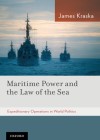Written by: James Kraska
Oxford University Press, New York,
2011, ISBN 9780199773381, 472 pp
Reviewed by: Allison Casey
Maritime Power and the Law of the Sea explores how mounting constraints to freedom of navigation in exclusive economic zones (EEZ)—the maritime area that stretches seaward from a coastal state’s baseline up to 200 nautical miles, as provided in the United Nations Convention on the Law of the Sea (UNCLOS)—could affect the role of expeditionary activities. While the sea is usually considered to be navies’ primary area of operation, as is the focus of this publication, this discussion comes at a time when Australia’s land power, namely Army, is expected to develop a more substantive role within a maritime strategy.
In this book, James Kraska makes the case that the tendencies of coastal states to put forward excessive maritime claims, which are often based on creative interpretations of UNCLOS, present adverse consequences for international security. As an underrepresented potential locus of conflict, Kraska argues, EEZs deserve far greater attention in the US oceans policy agenda than is currently allocated. This raises questions about how naval forces might be affected. In eight chapters, and with particular emphasis on sovereignty, security and environmental issues, Kraska develops an answer.
The quality of Kraska’s contribution is evident at a glance by the fact that it was awarded the US Navy League’s Alfred Thayer Mahan Prize in 2010. As a US Navy commander and the Howard S. Levie Chair of Operational Law at the US Naval War College, he is clearly positioned at the centre of current debates about the role of defence forces at sea. Indeed, Kraska has written widely on maritime strategy. In 2011 he published two full-length monographs (Maritime Power and the Law of the Sea and Contemporary Maritime Piracy) as well as editing and contributing to a third (Arctic Security in an Age of Climate Change). Kraska’s expertise in international law and naval experience combine seamlessly in this book, enabling him to present his wealth of knowledge about contemporary maritime strategy in a way that is both accessible and engaging. The chapter devoted to Law of the Sea regimes is especially noteworthy for its breakdown of UNCLOS provisions. By adopting a holistic view of these issues that incorporates geopolitical and military considerations, Kraska avoids a dry narrative that can sometimes be found in evaluations of international law.
Although the discussion progresses from a US standpoint—Australia’s Antarctic EEZ is used to illustrate an excessive yet relatively innocuous maritime claim that is inconsistent with UNCLOS—many of the conclusions in the final chapter resonate for Australian interests at sea. The need to establish greater cohesion among government agencies involved in oceans policy and the continued management of coastal state and naval power relations has long been prominent in discussions about Australian maritime strategy. Neither recommendation can be easily addressed. Yet as an island continent, Australia’s geography provides a long-term impetus to adopt a more active approach to regional maritime affairs and articulate a whole of government oceans policy.
Maritime Power and Law of the Sea is valuable for anyone interested in the core tenets of the Law of the Sea, the role of sea power and how the two interrelate. Given that the future shape of naval power in the Asia Pacific is not clear, regional economies’ continued ties to the maritime domain for their access to international commerce and Australia’s location adjacent to an archipelagic Southeast Asia, it is little wonder that Army’s need for a stronger maritime doctrine is so often pointed out. Kraska provides a compelling background to some of the major legal and operational issues that face seaborne expeditionary forces, many of which are relevant to Army’s maritime activity.

